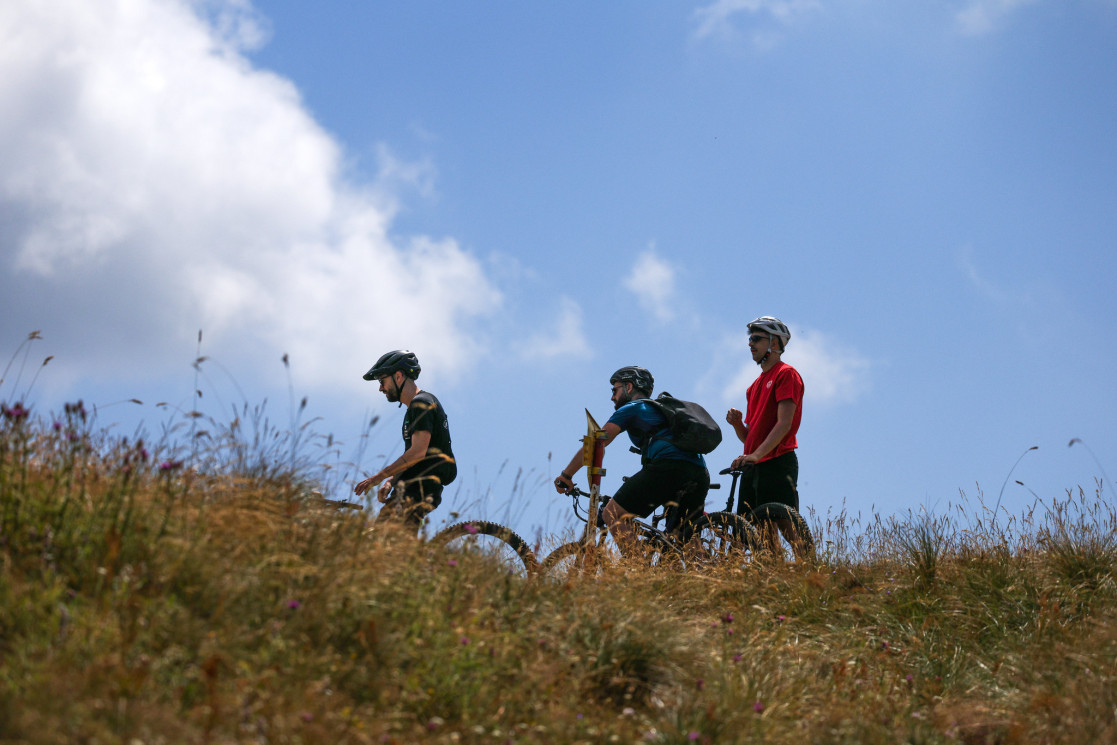Mountain meadows full of flowers stretch across the peak of Hinoskë in Dibër. There are wild blueberries, mountain tea, and various medicinal plants. This is at almost 2,000 meters above sea level. All the scents blend together to offer a unique taste of nature in the fresh air of alpine pastures.
A group of mountain bikers follows the cross-border trail connecting Albania and North Macedonia through tourism. They ride along bike paths built in a natural way that respects biodiversity. They cycle among flowers and wild plants. They are surrounded by pine forests and pastures. This area is mountainous and covered by snow for several months each year.
“No part of the trail was built from scratch. In Albania, every mountain and village has a path. This path connects the village to the mountain. This is due to our strong culture of livestock farming. Livestock create trails from the village to the pasture, whether near the village or high in the mountains. We used these paths. We were careful in our work. We did not use heavy machinery. Tour guide Orgest Noka says this. He worked with the EU-supported project ‘Cross-border Biking: Next Level Adventure Tourism in Mavrovo-Rostushe and Dibër’.
The initiative provided digital maps, construction work, signage, and markings for the 40 km trail. It spans 20 km in Albania and 20 km in North Macedonia. On the Albanian side, the trail passes through villages with scenic views. The architecture is traditional. These include Rabdishtë, Ilnicë, Melan, Pejç, Hotesh, Arapi i Epërm, and Katundi i Ri. Each village has its own signposts. These signposts show distances, maps, altitude, and coordinates. In total, 20 signposts and 40 information boards are installed. Many of these villages feature old stone houses, offering visitors cinematic views shaped over generations by local craftsmanship.
“From these trails, the longest uninterrupted downhill section is 6–7 km. It has quite a significant elevation difference, 1,200 meters. In this sport, elevation difference plays a major role. It helps in understanding the average slope of the trail. It also plays a part in measuring the fun factor. When you know the average slope, you can assess your ability. You decide if it’s a trail you can handle easily. It is one that will push your limits, or one that exhausts you. The greater the elevation difference, the more appealing it is,” explains Noka, a professional mountain biking guide.
Mountain bikers seek adrenaline. Yet, he always advises them not to exceed their limits. They should consider the area and the time needed to reach medical assistance in case of injury. There’s a saying among bikers. The level of satisfaction of a mountain biker is measured by the number of flies on his teeth. The happier he is, the more he smiles. As he rides quickly and joyfully, his teeth fill with flies,” he says with a laugh.
According to Noka, the greatest pleasure comes when bikers reach a state of flow. This occurs when they are in perfect sync with the trail. They should not push too hard to the point of danger. They also should not go so slowly that they lose excitement. “When you’re in the flow state, you achieve peak satisfaction. By the end of the trail, you’re happy because you’re not even tired,” he adds.
Visitors and tourists can choose to ride the trail from any village, or explore the area off-road with 4×4 vehicles. The trail is long and time-consuming. Many seek accommodation and restaurants along the way. This encourages locals to offer services and revive the area. “They usually stay overnight and enjoy more than one meal. Another highly demanded service for the longer trails is the shuttle. It is a taxi service for bicycles starting from the Hinoskë Mountains. When the trails are long, cyclists prefer going downhill. Instead of pedaling uphill, they use taxis to reach the peak. It’s off-road, but that makes it unique, it’s another experience in itself,” says Noka.
While pedaling, bikers can’t fully take in the stunning views of the hills, valleys, mountains and meadows. Their focus is on the trail, their breathing, the challenge, the fatigue, the pits, stones, roots and trees. But at every stop to recharge, the scenery, the villages and the mountains rekindle their connection with nature. Some rediscover themselves. Others find an authentic area to revisit. Together, they help create jobs and opportunities for local residents. This links two countries.
“Everyone discovers and enjoys an area where almost 1,000 species of flowers grow naturally in our mountains,” says Noka.

